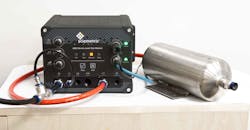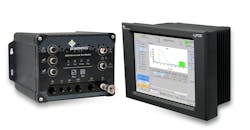Leak testing is a crucial diagnostic tool that helps manufacturers find any defects in parts that hold gas or liquids. If you’ve done it, you know that it can often be a frustrating and time-consuming process, with environmental variables possibly skewing results from part to part.
In 2014, Sciemetric, a manufacturing measurement company that works with Ford and Hewlett Packard, released a new kind of intelligent leak tester, the 3520 Series. It uses smarter sensors, precision electronics, and signature analysis to reduce faulty pass/fail results. It can test pressure decay and mass flow, and perform occlusion testing, volume testing, and burst testing, in volumes ranging from 1 cc to more than 400L.
Click here to our Directory side for the 3520 Series specs and more!
Because of the leak test accuracy, Ottawa-based Sciemetric says customers start seeing a ROI in less than six months from savings due to reduced warranty claims and scrap while increasing production. We talked to CTO Richard Brine about how it works:
NED: What is so frustrating about leak testing?
Leak testing is like running an experiment, and it’s challenging because multiple variables can affect it including changes in part temperature, atmospheric temperature, atmospheric pressure, the part’s internal volume, supply pressure, as well as seal creep or leak. For example, something as simple as a ventilation system turning on can affect part temperature dramatically. When you increase the pressure inside a part to test it you’ve just compressed the air in the part and increased its temperature as a result – now you have to deal with this thermal stabilization effect. Also, if you retest the same part without waiting for stabilization, you’ll get a completely different result. It makes for many interesting problems to solve.
So how is the 3520 Leak Tester different?
We build it from the ground up with ultimate accuracy and speed in mind, with ultra-low-noise electronic design, custom dual-electronic regulators, the latest Micro Electro Mechanical Systems (MEMS) tech transducers and many other optimized features. We also decided to separate the pneumatics from the HMI, so the leak tester is as close to the part under test and the HMI where it’s comfortable for the operator optimizing the leak test.
We also applied this same high-accuracy technology to the two temperature channels that can be used to measure atmospheric and part temperature, allowing for true temperature compensation.
Where should it go in the production line?
It should usually be placed as early as you can in the assembly process, so there’s less scrap if you do find a defect. If you caught that leak further down the line, you’d have more scrap or more work to disassemble the components. Or worst case, it gets to your customer.
The separate leak tester allows you to place it even on a robotic arm, drastically reducing hose length, and thus the volume of the system, as well as making the best coupling to the part. Any time you reduce test volume, you increase accuracy.
And how does this leak test fit into the Industrial Internet of Things?
Our roots are in data. We’ve been collecting all the raw signatures, the detailed waveforms for many years now. So it’s not just an isolated data point like leak rate – you’re getting the entire flow curve, the entire pressure curve. We put in all the diagnostic sensors so you’re also getting the supply pressure curve, the pilot pressure curve and others. This allows you to do root cause analysis at a rapid rate. You can store tens of thousands of test records, and we offer our QualityWorX database for a complete history for the leak tester and any system on the line. With this data, you can make better decisions. And that leads to higher yields, optimized processes, and obviously higher quality products.
So how has it worked so far?
One manufacturer making carburetors for small engines had a leak in a certain seal, and tried to mitigate it by installing eight leak testers. They had people manually talking parts off line to feed the leak tests. By going to the 3520, they were able to remove the offline stations and go to just four online, running regular production. Most of the time, longer leak tests are more accurate, however, the 3520 produced much better results in half the cycle time, giving the manufacturer a shorter and more accurate leak test.
About the Author
John Hitch
Editor, Fleet Maintenance
John Hitch, based out of Cleveland, Ohio, is the editor of Fleet Maintenance, a B2B magazine that addresses the service needs for all commercial vehicle makes and models (Classes 1-8), ranging from shop management strategies to the latest tools to enhance uptime.
He previously wrote about equipment and fleet operations and management for FleetOwner, and prior to that, manufacturing and advanced technology for IndustryWeek and New Equipment Digest. He is an award-winning journalist and former sonar technician aboard a nuclear-powered submarine where he served honorably aboard the fast-attack submarine USS Oklahoma City (SSN-723).


